I want to release an app to Azure and deploy migrations to a database before deploying the Web App. That sounds relatively simple, you can create a migrations.sql script with dotnet-ef in your Build pipeline and apply this script in your Release pipeline.
However, I cannot create a a migrations.sql script in the Build pipeline as I am using four different databases for a DTAP environment. Thus, I would need to generate a migrations.sql script per environment and perform these separately against each of the databases. (as I understand it)
In my Release pipeline I use an incremental ARM template to deploy resources and set the ConnectionString (which comes from an Azure Key Vault) in the Azure Web App application settings configuration.
How/where do I generate the migrations.sql script? Do I do this in a Release pipeline? Am I making a major mistake in my reasoning?
EDIT:
Thanks for Madej's answer that shows the environment doesn't matter. I tried implementing creating the migrations.sql script in my pipelines.
# ASP.NET Core (.NET Framework)
# Build and test ASP.NET Core projects targeting the full .NET Framework.
# Add steps that publish symbols, save build artifacts, and more:
# https://learn.microsoft.com/azure/devops/pipelines/languages/dotnet-core
trigger:
- master
pool:
vmImage: 'windows-latest'
variables:
projects: '**/*.csproj'
buildPlatform: 'Any CPU'
buildConfiguration: 'Release'
steps:
- task: DotNetCoreCLI@2
displayName: "Install dotnet-ef"
inputs:
command: 'custom'
custom: 'tool'
arguments: 'install --global dotnet-ef'
- task: DotNetCoreCLI@2
displayName: "Restore tools"
inputs:
command: 'custom'
custom: 'tool'
arguments: 'restore'
- task: DotNetCoreCLI@2
displayName: "Restore"
inputs:
command: 'restore'
projects: '$(projects)'
feedsToUse: 'select'
- task: DotNetCoreCLI@2
displayName: "Build"
inputs:
command: 'build'
projects: '$(projects)'
arguments: '--configuration $(BuildConfiguration)'
- task: DotNetCoreCLI@2
displayName: "Create migrations.sql"
inputs:
command: 'custom'
custom: 'ef'
arguments: 'migrations script --configuration $(BuildConfiguration) --no-build --idempotent --output $(Build.ArtifactStagingDirectory)\migrations.sql'
workingDirectory: 'WebApi.api'
- task: DotNetCoreCLI@2
displayName: "Publish"
inputs:
command: 'publish'
publishWebProjects: true
arguments: '--configuration $(BuildConfiguration) --output $(Build.ArtifactStagingDirectory)'
zipAfterPublish: false
- task: PublishBuildArtifacts@1
displayName: "Publish to Azure Pipelines"
inputs:
PathtoPublish: '$(Build.ArtifactStagingDirectory)'
ArtifactName: 'drop'
publishLocation: 'Container'
My pipeline doesn't work, in the task "Create migrations.sql" I run into the following error:
An error occurred while accessing the Microsoft.Extensions.Hosting services. Continuing without the application service provider. Error: DefaultAzureCredential failed to retrieve a token from the included credentials.
- EnvironmentCredential authentication unavailable. Environment variables are not fully configured.
- ManagedIdentityCredential authentication unavailable. No Managed Identity endpoint found.
- Visual Studio Token provider can't be accessed at C:\Users\VssAdministrator\AppData\Local\.IdentityService\AzureServiceAuth\tokenprovider.json
- Stored credentials not found. Need to authenticate user in VSCode Azure Account.
- Please run 'az login' to set up account
This is because in my Program.cs I add a keyvault and authenticate with the Azure.Identity DefaultAzureCredential as follows:
public static IHostBuilder CreateHostBuilder(string[] args) =>
Host.CreateDefaultBuilder(args)
.ConfigureWebHostDefaults(webBuilder =>
{
webBuilder.ConfigureAppConfiguration((hostingContext, config) =>
{
var settings = config.Build();
var credentials = new DefaultAzureCredential(
new DefaultAzureCredentialOptions() {
ExcludeSharedTokenCacheCredential = true,
VisualStudioTenantId = settings["VisualStudioTenantId"],
}
);
config.AddAzureKeyVault(new Uri(settings["KeyVault:Endpoint"]), credentials).Build();
})
.UseStartup<Startup>();
});
The Azure Pipelines cannot get a token from DefaultAzureCredential. How do I authenticate the Azure Pipelines?

